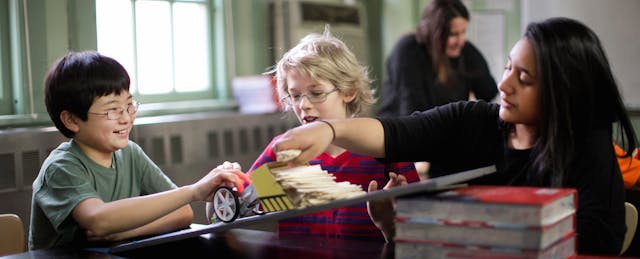LittleBits’ latest product, the STEAM (Science, Technology, Engineering, Art and Math) Student Set, debuts March 8, and it mirrors CEO Ayah Bdeir’s own personal history: “I wanted to be a designer,” she said, “but my parents said I owed to myself to be an engineer.” She became both.
The STEAM Student Set is the first product from the electronic toy company that focuses specifically on littleBits’ educational uses. While Bdeir said that 12,000 educators in over 100 countries have embraced the Gizmos and Gadgets Kit, this is the first time her company has made, as she calls it, “a complete out of the box experience for teachers and students.”
Aimed at grades three through eight, the kit will feature blocks from the same library of littleBits parts, albeit presented differently. The ancillary materials differentiate it from other littleBits kits. The company has developed littleBits professional development, a six-hour online course from which educators can earn a certification that will support educators integrating STEAM into their classrooms, to supplement the kit for a fee. Also new is the Student Invention Guide, which contains guided invention challenges from “Invent a Self-Driving Vehicle” to “Hack Your Habits,” pointing young inventors to new configurations of their blocks.
The first iteration of littleBits aimed to equip kids to invent, according to Bdeir, and she wants the new iteration to give educators the tools to teach what she calls “invention-based learning”—essentially project based learning with the fairy dust of encouraged creativity. The goal of the new supplementary materials, she said, is to bring more teachers into the Maker Movement and to shepherd the movement into the mainstream. Both have been among her chief goals for years.
“The challenge now is gaining traction outside early adopters,” she said. “We’re interested in educators who love STEM/STEAM and those who are afraid of it or don’t think they’re ready for it or that it’s not for them. We want to alleviate their concerns and lower the barrier of entry”
In a September 2015 piece for EdSurge, she also wrote, “It’s time for Maker Ed to move into the mainstream. Making should not be relegated to the times spent outside of class, e.g. lunch or after school. Nor should it only flourish in private schools, which don’t have to teach to standards.”
She may be onto something; large educational programs have already snapped up the new product. The New York City Department of Education has signed a contract to use the STEAM Student Set in its 2016 summer enrichment program: 2,200 students in grades two through five will play with the kit four days a week for five weeks.
Why STEAM and not STEM?
STEM: Science, Technology, Engineering and Math
STEAM: Science, Technology, Engineering, Art and Math
The debate rages on. Critics say STEAM dilutes the emphasis on technical subjects that STEM is supposed to foster. Advocates say STEAM inserts a necessary element of creativity and excitement that STEM lacks.
“I believe that cutting art out is a mistake,” Bdeir said. “Iteration, creativity and accepting failure are all essential design concepts that you can learn from the arts. This type of learning is foundational for whatever you want to do, not just becoming an engineer.”
Bdeir’s own path follows a progression from STEM to STEAM. She studied computer engineering at the American University of Beirut, but it wasn’t until studying at the MIT Media Lab that she became excited about her chosen discipline.
“I was tired of engineering when I completed undergrad,” she said, “but in grad school I started creating art with code, which got me experimenting with technology. Then I was in Neil Gershenfeld’s ‘How to Make Almost Anything,’ and we were tasked with inventing something new every week. It was a challenging and absolutely critical turning point for me.” In the class, she attempted to make a CD rack, which fell apart, but succeeded in prototyping a wall with embedded electromagnets that would reshape the wall as people walked by. She credits these creative assignments with inspiring her to make littleBits.
Bdeir isn’t the only one arguing for the diversification of the sciences. Part of President Obama’s CS4All initiative is the push for not just using CS to become an engineer but also to become involved in any profession that may need an element of computer science, whether that be running a restaurant or designing an animated character.
As for the lessons of iterating and accepting failure, Bdeir said she remembers them every day that she’s lucky enough to still be CEO of littleBits.
“In the early days of the company, I thought everything would fall apart every day,” she said. “Then it was every week, then month. The mark of making headway is that these freakouts fall farther and farther apart.”
Correction, March 15, 2016: A previous version of this article stated that littleBits professional development was free with purchase of the STEAM Student Set. It is not.


